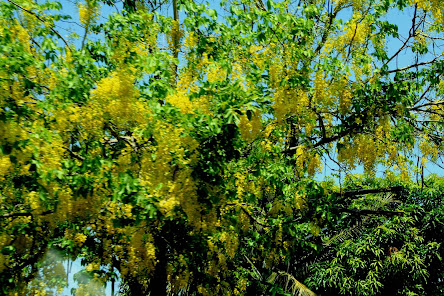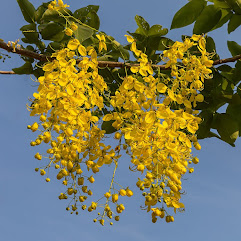Travelogue in Time and Space in Paintings
and Verses (7 Destinations)
Paintings and Verses by Dr Abe V Rotor
Allegory Cave
The Cave of Knowledge in acrylic by the author 2022,
represents the allegory cave of the Greek philosopher Plato.*
On display at the San Vicente Botanical Garden (IS)
In some dark cave humans lived in ignorance and fantasy,until one escaped and followed the passing shadow, goes the story,and found a bigger world we know today, beautiful and free;but he never returned to tell the others of his great disvovery.Thus, there are still many who are living in ignorance and fantasy.
Monsoon on the highland
Monsoon in acrylic by the author 2022. Painting
on dislay at the San Vicente Botanical Garden IS)
Roar in thunder and tumble on the rocks overthe stream to herald the coming of monsoon;wake the seeds and the field in long slumber,the disciples of Aergia, goddess of the lazy bone.
Spent Waterfall
Eroded Waterfall in acrylic by the author, 2022
Hidden from man for eons in the wild,until found in his search for beauty.Oh, what an irony indeed is discovery,and the essense of rationality?
Glazed Clay from Volcanic Eruption
Volcanic Rock in acrylic by the author circa 1960,
actually glazed clay found in a tobacco barn furnance,
a process burnay (glazed jar) is made. On display
among rock collection at the Living with Nature center.
From dust to dust, save the clay glazed
by fire into crust;
from dust to rock, nature takes shape,
and returns to dust.
Remnants of Forest Fire
Ruin and Regeneration in acrylic by the author 2020,
relief on wood, superimposed with stones and twig.
On display at the San Vicente Botanical Garden (IS)
Bone dry after the conflagration, the landscape
breathes a generation;
rebuilding the lost vegetation from underground,
we call resurrection;
fire destroys and fire rebuilds, it's Nature's cycle
of regeneration.
Where have all the wildlife gone?
Sculpt head of Philippine deer against a wall mural
of a spoiled landscape painted by the author, 2020.
On display at San Vicente Botanical Garden (IS)
Their habitats forever gone, invaded and destoyed,
by man's greed and folly, and rush;
where have all the wildlife gone, we ask ourselves;
Pogo says, no one is to blame but us.
A Garden in Space
The Living Universe in acrylic on wood by the author,
depicts the abundance of primordial vegetation freely
suspended in space, contrary to emptiness and darkness,
save the twinkling stars in romantic fantasy.
Our planet Earth is but a grain of sandin the universe;little do we know what is far beyondsince the Big Bang's burst.What is emptiness in outer space,but life in darkness;the elements found on earth aboundin the same likeness.Eden is not lost after all, we praise;so with life before;our little knowledge of the Mysteryleads us to its core. ~















.jpg)
























Virgin coconut oil is perhaps the most important product derived from coconut as elixir – and now as anti-bacterial medicine.
This finding is based on the response of ten selected strains of Mycobacterium tuberculosis (Mtb) on exposure for 24 hours to the minimum inhibitory concentration of GML, which is on the level of 250 micrograms per milliliter (ug/ml).
This is comparable to the effectiveness of anti-TB drugs (streptomycin, isoniazid, rifampicin, and ethamburol), and in fact, GML proved effective to one bacterial strain which is resistant to isoniazid.
The growth of seven confirmed M tubercolusis clinical strains isolated from sputa of TB cases was found to be inhibited by the same glycerol monolaurate concentration.
This result was presented by Jonathan Cabardo in his dissertation for a PhD degree in biological science at the University of Santo Tomas. His adviser is Dr Delia Ontengco, a well known microbiologist and professor at the UST Graduate School.
I asked Dr Cabardo the mechanics on how the tuberculosis bacteria are attacked and killed by GML. This is how he explained it.
“The various morphological changes observed in GML-exposed cells were absence or discontinuity of the outer layer of the cell, wide spaces between the cell membrane and the outer electron-dense layer of the cell envelop, suggesting the shrinking of the cell, vacant spaces within the cell, partial or complete loss of cellular components, burst cells that caused leaking out of the cellular materials into the medium, and plain cellular debris in the medium. Furthermore cell division was not apparent in GML-exposed cells.”
The impressive results of the study give clear evidence that GML can kill the highly pathogenic Mycobacterium tuberculosis, both drug susceptible and resistant strains. Isoniazid-resistant cells were also killed by GML, suggesting that GML is not affected by the mechanism that causes Mtb resistance to isoniazid, a primary drug for active tuberculosis.
It is concluded that GML is mycobactericidal at 250ug/ml. It is recommended that further tests be conducted on other active tuberculosis cases to expand the medicinal and economical value of glycerol monolaurate or monolaurin, a derivative of virgin coconut oil. x x x
Reference: ad VERITATEM: Multi-Disciplinary Research Journal of the UST Graduate School, Volume 8, Number 1 October 2008. Acknowledgement: photos from Wikipedia.
Posted by Abe V. Rotor at 10:01 PM
Email ThisBlogThis!Share to TwitterShare to FacebookShare to Pinterest
5 comments:
Wow! Congratulations to Dr. Jon Cabardo. His findings were so significant since most Philippine TB patients have access to virgin coconut oil. Way to go Jon! I hope to hear from you and Doc Rotor about traditional medicine that are not yet scientifically tested.
Doc Rotor, you are always my mentor whom I look up to and tries my best to emulate. It is through you that I saw art in science and science in art. Thank you very much for your influence. God bless!August 10, 2009 at 1:11 PM
Hi,
Since 1980, Tuberculosis has skyrocketed from over 200,000 cases to over 500,000! This astonishing number is a sign that organizations, such as yours, are important now, more than ever. As I read through your website, it is clear that we share the same passion in fighting this horrible disease. Here at, Disease.com, we are dedicated to the prevention and treatment of diseases. If you could, please list us as a resource or host our social book mark button, it would be much appreciated. We may not physically heal the suffering, but lets support their cause.
If you need more information please email me back with the subject line as your URL.
Thank You,
Sharon Vegoe
Disease.comDecember 12, 2009 at 2:13 AM
Dear Dr. Rotor;
I suspect that anacardic acids would kill Streptococcus and Staphylococcus bacteria.
I have found that the anacardic acids in raw cashew nuts and maybe mangoes do an excellent job of curing an abscess from gram positive bacteria, which are the most prevalent cause of tooth decay and tooth aches You may see my article on this subject at; http://charles_w.tripod.com/tooth.html . It is also discussed briefly in the 2005 edition of Medical Hypotheses, 65; 289-292. Wikipedia discusses anacardic acids in http://en.wikipedia.org/wiki/Anacardic_acid .
I would like to urge you to explore making these medicines available in the pure form from pharmacies for a Streptococcus medicine or in tooth paste. This would have several advantages; 1. a variety of application methods would be possible, needles, brushes, swabs, sprays, and etc. 2. It would probably eliminate allergy. 3. It would probably be less expensive than cashews. 4. It would be easier to apply massively locally. 4. It would be easier to test against the pathogenic species involved. 5. It would be more emotionally acceptable to the medical profession who tend to prefer chemicals over anything as amateurish as natural products. 6 It would be easier to control amounts. 7. It would be easier to carry it on camping trips, etc. 7. It would probably have an infinite shelf life.
Anacardics would be much more effective in killing decay bacteria than fluoride and without the dangerous side effects (see http://charles_w,tripod.com/fluoride.html ). This would be especially valuable since these medicines would probably prove to be valuable against other gram positive diseases such as acne, leprosy, Streptococci, Staphylococcus aureus, anthrax, Listeria monocytogenes, Actinomyces naeslundi, Corynebacterium diphtheriae, Streptococcus agalactiae, Propionibacterium spp, and maybe even tuberculosis as well.
Acute Streptococcus pyogenes infections may present as pharyngitis (strep throat), scarlet fever (rash), impetigo (infection of the superficial layers of the skin) or cellulitis (infection of the deep layers of the skin). Invasive, toxigenic infections can result in necrotizing fasciitis, myositis and streptococcal toxic shock syndrome. Patients may also develop immune-mediated post-streptococcal sequelae, such as acute rheumatic fever and acute glomerulonephritis, following acute infections caused by Streptococcus pyogenes. Streptococcus pyogenes produces a wide array of virulence factors and a very large number of diseases. Virulence factors of Group A streptococci include: (1) M protein, fibronectin-binding protein (Protein F) and lipoteichoic acid for adherence; (2) hyaluronic acid capsule as an immunological disguise and to inhibit phagocytosis; M-protein to inhibit phagocytosis (3) invasins such as streptokinase, streptodornase (DNase B), hyaluronidase, and streptolysins; (4) exotoxins, such as pyrogenic (erythrogenic) toxin which causes the rash of scarlet fever and systemic toxic shock syndrome. (see http://textbookofbacteriology.net/themicrobialworld/strep.html )
Sincerely, Charles Weber
April 30, 2014 at 7:11 AM
My name is hoover, my 18 year old daughter, Tricia was diagnosed with herpes 3 years ago. Since then, we have moved from one hospital to another. We tried all kinds of pills, but every effort to get rid of the virus was futile. The bubbles continued to reappear after a few months. My daughter was using 200mg acyclovir pills. 2 tablets every 6 hours and 15g of fusitin cream. and H5 POT. Permanganate with water to be applied twice a day, but all still do not show results. So, I was on the internet a few months ago, to look for other ways to save my only son. Only then did I come across a comment about the herbal treatment of Dr Imoloa and decided to give it a try. I contacted him and he prepared some herbs and sent them, along with guidance on how to use them via the DHL courier service. my daughter used it as directed by dr imoloa and in less than 14 days, my daughter recovered her health. You should contact dr imoloa today directly at his email address for any type of health problem; lupus disease, mouth ulcer, mouth cancer, body pain, fever, hepatitis ABC, syphilis, diarrhea, HIV / AIDS, Huntington's disease, back acne, chronic kidney failure, addison's disease, chronic pain, Crohn's pain, cystic fibrosis, fibromyalgia, inflammatory Bowel disease, fungal nail disease, Lyme disease, Celia disease, Lymphoma, Major depression, Malignant melanoma, Mania, Melorheostosis, Meniere's disease, Mucopolysaccharidosis, Multiple sclerosis, Muscular dystrophy, Rheumatoid arthritis Alzheimer's disease, parkinson's disease, vaginal cancer, epilepsy Anxiety Disorders, Autoimmune Disease, Back Pain, Back Sprain, Bipolar Disorder, Brain Tumor, Malignant, Bruxism, Bulimia, Cervical Disc Disease, Cardiovascular Disease, Neoplasms , chronic respiratory disease, mental and behavioral disorder, Cystic Fibrosis, Hypertension, Diabetes, Asthma, Autoimmune inflammatory media arthritis ed. chronic kidney disease, inflammatory joint disease, impotence, alcohol spectrum feta, dysthymic disorder, eczema, tuberculosis, chronic fatigue syndrome, constipation, inflammatory bowel disease. and many more; contact him at drimolaherbalmademedicine@gmail.com./ also with whatssap- + 2347081986098.May 16, 2020 at 12:02 PM
I trust virgin coconut oil. I'm actually a small producer of my VCO branded BJ's Premium VCO.
Am in Papua New Guinea. I sent my product to Pacific Lab,Singapore and tested and certified fit for consumption.
Alot of people have been getting healed from various illnesses.
Ranging from cancer to TB and any acute or rare diseases, including immune system build up in HIV-AIDS patients.
You can check out our Facebook page BJ's Premium VCO or call us on (675) 79919972.
Cheers,
Bruce.February 1, 2021 at 1:02 PM